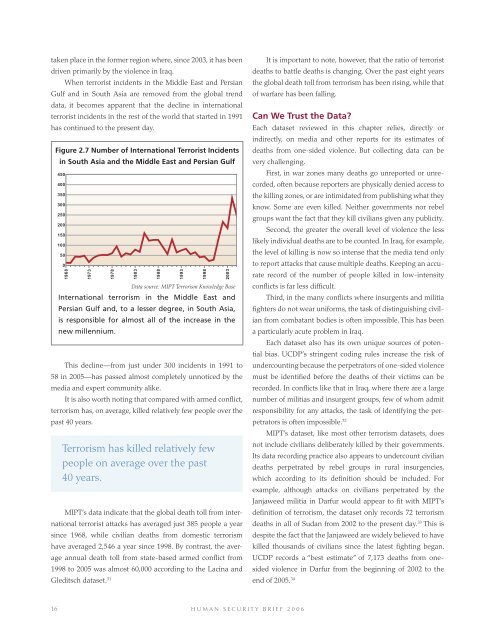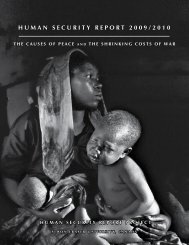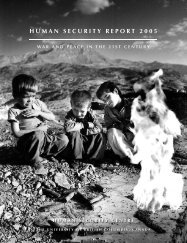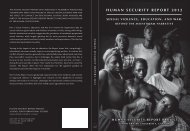H U M A N S E C U R I T Y B R I E F 2 0 0 6
H U M A N S E C U R I T Y B R I E F 2 0 0 6 - Human Security Report ...
H U M A N S E C U R I T Y B R I E F 2 0 0 6 - Human Security Report ...
You also want an ePaper? Increase the reach of your titles
YUMPU automatically turns print PDFs into web optimized ePapers that Google loves.
taken place in the former region where, since 2003, it has beendriven primarily by the violence in Iraq.When terrorist incidents in the Middle East and PersianGulf and in South Asia are removed from the global trenddata, it becomes apparent that the decline in internationalterrorist incidents in the rest of the world that started in 1991has continued to the present day.Figure 2.7 Number of International Terrorist Incidentsin South Asia and the Middle East and Persian Gulf4504003503002502001501005001968197319781983Data source: MIPT Terrorism Knowledge BaseInternational terrorism in the Middle East andPersian Gulf and, to a lesser degree, in South Asia,is responsible for almost all of the increase in thenew millennium.This decline—from just under 300 incidents in 1991 to58 in 2005—has passed almost completely unnoticed by themedia and expert community alike.It is also worth noting that compared with armed conflict,terrorism has, on average, killed relatively few people over thepast 40 years.Terrorism has killed relatively fewpeople on average over the past40 years.MIPT’s data indicate that the global death toll from internationalterrorist attacks has averaged just 385 people a yearsince 1968, while civilian deaths from domestic terrorismhave averaged 2,546 a year since 1998. By contrast, the averageannual death toll from state-based armed conflict from1998 to 2005 was almost 60,000 according to the Lacina andGleditsch dataset. 311988199319982003It is important to note, however, that the ratio of terroristdeaths to battle deaths is changing. Over the past eight yearsthe global death toll from terrorism has been rising, while thatof warfare has been falling.Can We Trust the Data?Each dataset reviewed in this chapter relies, directly orindirectly, on media and other reports for its estimates ofdeaths from one-sided violence. But collecting data can bevery challenging.First, in war zones many deaths go unreported or unrecorded,often because reporters are physically denied access tothe killing zones, or are intimidated from publishing what theyknow. Some are even killed. Neither governments nor rebelgroups want the fact that they kill civilians given any publicity.Second, the greater the overall level of violence the lesslikely individual deaths are to be counted. In Iraq, for example,the level of killing is now so intense that the media tend onlyto report attacks that cause multiple deaths. Keeping an accuraterecord of the number of people killed in low-intensityconflicts is far less difficult.Third, in the many conflicts where insurgents and militiafighters do not wear uniforms, the task of distinguishing civilianfrom combatant bodies is often impossible. This has beena particularly acute problem in Iraq.Each dataset also has its own unique sources of potentialbias. UCDP’s stringent coding rules increase the risk ofundercounting because the perpetrators of one-sided violencemust be identified before the deaths of their victims can berecorded. In conflicts like that in Iraq, where there are a largenumber of militias and insurgent groups, few of whom admitresponsibility for any attacks, the task of identifying the perpetratorsis often impossible. 32MIPT’s dataset, like most other terrorism datasets, doesnot include civilians deliberately killed by their governments.Its data recording practice also appears to undercount civiliandeaths perpetrated by rebel groups in rural insurgencies,which according to its definition should be included. Forexample, although attacks on civilians perpetrated by theJanjaweed militia in Darfur would appear to fit with MIPT’sdefinition of terrorism, the dataset only records 72 terrorismdeaths in all of Sudan from 2002 to the present day. 33 This isdespite the fact that the Janjaweed are widely believed to havekilled thousands of civilians since the latest fighting began.UCDP records a “best estimate” of 7,173 deaths from onesidedviolence in Darfur from the beginning of 2002 to theend of 2005. 3416H U M A N S E C U R I T Y B R I E F 2 0 0 6






